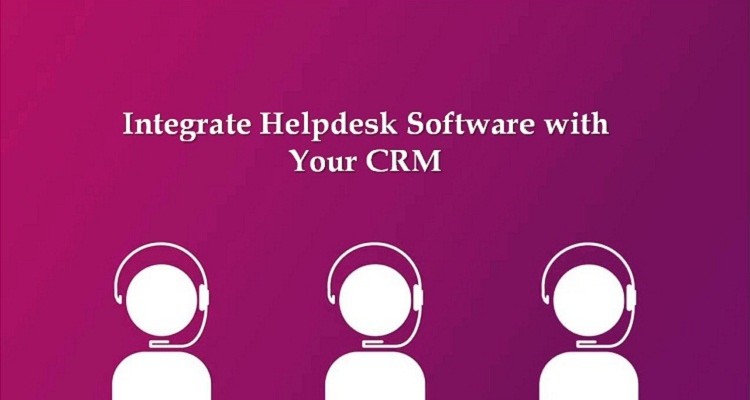How To Integrate Your Helpdesk Software with Your CRM
Deploying two separate systems to cater to the same customer can not only be time-consuming but also more costly. According to experts, the best path to optimizing business and be successful is to integrate two individual parts of the business in one.
The most important parts to integrate with each other are your helpdesk and CRM software. This integration is cost-effective and manages the customer conversation flow perfectly. What they need and what you are providing is pretty clear, and you can use this integration to work on the improvements.
And here’s why you should integrate your helpdesk and CRM software.
Single Database
The most important part of the integration is having all the customer data – from the time of nurturing to after sales – under one single roof. There is no need to exchange mails between the product and support team or between the sales and the support team to understand what went wrong with the product or the purchase. All the teams can see the customer profile, account information and the communication exchanged.
Improves Customer Satisfaction
Having an integrated system will allow you to have a better conversation with your customer. It helps your service reps to deliver services that seem personal because the system has the complete picture of the customer’s profile. Integrating helpdesk and CRM syncs the customer’s data while providing a two-way flow of communication between the help desk and other processes. You can access data such as full customer information, past communication, payment or billing information, help desk tickets and customer’s feedback or ideas.
Provides Faster Solutions
This integration actually syncs the sales and support teams together, which brings equal collaboration while resolving customer tickets. Both the teams have had equal amount of communication with the customer but sales does it before sales and support does it after sales. So the various data on customer’s profiling and requirements can be exchanged to provide a better solution to the customer. Using this integration, both the teams can view the tickets raised and update the data based on the issue.
Boosts Team Efficiency
Having all the data under one single system helps in tracking the customer trends easily and effectively. Using this integration, your support team can automate manual tasks and receive real-time alerts that will improve their response efficiency. Through this your team can check various reports, ticket data, and unresolved issues. This will help in understanding the workflow efficiency and calculate the team’s productivity.
Integrations are always good for business, especially when it brings synchronization and effectiveness in various processes and teams. Another crucial reason to integrate important business parts is to cut down on your investments.
[bctt tweet=”The most important parts to integrate with each other are your helpdesk and CRM software.” username=”agilecrm”]
Now that you understand why you should integrate these two systems together, let’s focus on how to go about with this integration:
Identify Tasks that Needs to be Automated
When deciding to integrate your helpdesk with CRM, you need to first identify the tasks you want to automate and how they should sync with other processes. The crucial tasks that your help desk needs to automate are ticketing, workflows, responses and service recommendations. The next part is to identify the widgets that you would want to integrate between these systems. The important widgets are telephony, billing, social and support.
Seamless Synchronization of the Systems
You have the tasks that need to be automated and the widgets you need to automate this process, now look at how you can integrate it. Both the systems need to be synced in the most seamless way possible so that if any customer raises a ticket in the system, there needs to be an alert in your CRM. It should be able to:
- Import all the contacts from the help desk in your CRM to have data under one platform.
- Sync customer data and tickets with your CRM contacts’ data for single and better view of contacts’ data.
- Connect with sales and ticket data to ensure that sales team can view, create and update tickets that are familiar to the team.
- Share customer data such as user profiles, customer account size and more, or data that is relevant to the issue or ticket.
- Provide business insights through synced data to improve workflow efficiency and customer queries.
helpdesk is always on the move – talking, mailing or meeting other teams – so it becomes important that manual tasks are automated whenever possible and have specific alerts for various workflows. Another part that this integration should help in is categorizing customer tickets depending on the plan (paid or non-paid) and priority (VIP or non-VIP).
Once you identify all these criteria, then just choose the helpdesk you want to integrate with your CRM system. If you are looking at these exact criteria, then you can try Agile CRM that is integrated with helpdesk.

3 Comments
Colin
about 9 years agowhat about integration with freshdesk? ideally done direct and not with zappier
ReplyChandan K. Jilukara
about 9 years agoHi Colin, Thanks for your comment. Currently, we do not have direct integration with Freshdesk. It would be a good idea to explore more. We request you to add the request to our UserVoice (https://agilecrmcom.uservoice.com/). Based on the number of votes we will take up the feature request.
ReplyTremaine
about 8 years agoHi Colin, I personally found a workaround to this. Simply create an separate email account and change the settings for Freshdesk to copy in that email. Then in Agile CRM just connect that email. I use google apps so it was pretty simple but the other email connection methods should work too.
Reply